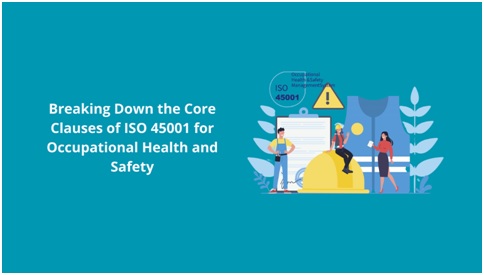The well-being and safety of workers must always come first. A thorough framework for creating and maintaining efficient occupational health and safety (OH&S) management systems is provided by the ISO 45001 standard. Organisations can build safer workplaces, lower accident rates, and improve general well-being by following the ISO 45001 criteria. This blog explores the fundamental ISO 45001 Clauses, examining its key elements and underlining the value of ISO 45001 Training for professionals looking to traverse these provisions properly.


Understanding ISO 45001 Clauses
The ISO 45001 standard is divided into clauses describing how to implement a successful OH&S management system. These provisions offer a systematic approach to locating, managing, and reducing occupational health and safety hazards. By comprehending these clauses, organisations can develop safer working environments and promote a healthy culture.
Core Clauses of ISO 45001
Let’s examine the ISO 45001 Core Clauses:
Clause 4: Organisational Context
The significance of understanding the organisation’s internal and external context, including factors that could affect OH&S’s performance, is highlighted in this sentence. Organisations must identify the relevant stakeholders and their expectations.
Clause 5: Worker Participation and Leadership
Leadership commitment is necessary for the development of an effective OH&S management system. The necessity of top management involvement and engagement is emphasised, and employee participation and consultation are encouraged.
Clause 6: Planning:
Planning comprises assessing OH&S risks and opportunities, identifying objectives, and creating a strategy to achieve those objectives. Organisations must consider the obligations of the law and other important stakeholders.
Clause 7: Support:
This clause includes documentation, resources, knowledge, awareness, and communication. Employees must be capable and aware of OH&S challenges, and enough resources must support the OH&S management system.
Clause 8: Operation:
The operation includes carrying out the planned actions, controlling risks, and managing modifications. Risk assessment, emergency preparation, hazard identification, and effective operational controls are required.
Clause 9: Performance Review
Organisations need to monitor, assess, analyse, and evaluate their OH&S performance about objectives and standards. This clause requires regular audits, incident investigations, and performance reviews.
Clause 10: Improvement:
The main concept of the ISO 45001 standard is continuous improvement. This phrase underlines the value of corrective action, incident learning, and system improvement as needed for OH&S management.
The Significance of ISO 45001 Clauses
The following are the benefits of ISO 45001 Clauses:
- By addressing several factors, including leadership commitment, risk assessment, worker involvement, and continual development, the provisions offer a comprehensive strategy for managing OH&S.
- Organisational compliance with pertinent legal and regulatory obligations relating to occupational health and safety is ensured by ISO 45001 provisions.
- The provisions direct businesses in risk assessment and management, reducing the possibility of mishaps and incidents.
- Organisations can show their dedication to the health and safety of their workers by adhering to the ISO 45001 clauses.
The Role of ISO 45001 Training
Training in ISO 45001 provides professionals with the information and abilities they need to implement and traverse the standard’s main clauses successfully. The fundamentals of OH&S management, risk assessment techniques, and the actual implementation of ISO 45001 regulations are all covered in training programmes. Professionals who receive training can help make workplaces safer, reduce risks, and guarantee adherence to OH&S requirements.
Conclusion
The fundamental provisions of ISO 45001 serve as the cornerstone of successful occupational health and safety management systems. Organisations can prioritise the safety of their workers, lower workplace accidents, and foster a culture of safety by following these provisions. Specialised ISO 45001 training may help professionals understand the nuances of ISO 45001 and efficiently use its principles, ensuring their work aligns with international best practices for occupational health and safety.









